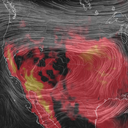Southwest heat wave intensifies, 40 million likely to see 100-degree temperatures

A punishing and long-enduring heat wave is intensifying in parts of the West and Southwest, with heat warnings and advisories in effect across seven states Wednesday. The heat will not relent until late in the weekend.
Threat level: In the coming days, 40 million are likely to see temperatures reach or exceed 100 degrees.
Why it matters: The extreme heat is unusually intense for June, and is aggravating already dire drought conditions that could lead to another devastating wildfire season.
The details: Overnight minimum temperatures in Las Vegas barely slipped below 90°F early Wednesday, and daytime highs are anticipated to approach the city’s all-time record of 117°F today through Saturday.
- In Phoenix, the low temperature Tuesday night into Wednesday warming was a stifling 91°F.
- The heat wave is the result of a sprawling area of high pressure at the surface and aloft, also known as a heat dome. It's deepening the already extreme drought across the West, and adding to the significant wildfire danger across the region.
- Wildfire risks are especially heightened from Arizona to California, northeastward into Montana. In Arizona and New Mexico, lightning from scattered thunderstorms could trigger new wildfires beginning Wednesday, as they mainly bring dry lightning and dust to a parched region.
By the numbers: In Death Valley, Calif., which holds the distinction of having recorded the hottest temperature on Earth, the June high-temperature record of 129°F is likely to be threatened Wednesday and Thursday. Death Valley hit 124°F on Tuesday.
- The average temperature there for this time of year is about 110°F.
Several noteworthy records were tied or fell on Tuesday, including:
- 107°F in Salt Lake City, tying the city’s all-time record for anytime of the year and beating its previous record for hottest temperature in June, which had stood at 106°F.
- Billings, Montana also tied its all-time hottest temperature on record for any month with a high of 108°F on Tuesday.
- Laramie, Wyo. tied its all-time high temperature record of 94°F on Tuesday.
In addition, dozens of locations in the West and Southwest set daily high temperature and record high overnight minimum temperatures on Tuesday into Wednesday, with numbers likely to total in the hundreds by this weekend.
What we're watching: The drought conditions mean there is less hydroelectric power available to handle surges in power demand across the Southwest. Lake Mead, for example, has hit its lowest levels since it was first filled in the 1930s, cutting power production at the Hoover Dam.
- In California, temperatures are starting to increase in the Sacramento and San Joaquin River Valleys along with the foothills of the snowless Sierras, with highs around 110 degrees forecast for Thursday.
- The National Weather Service is warning that both daytime high temperature and overnight low temperature records are likely to be broken through the weekend across inland California, and parts of the Four Corners region.
- So far the peak of the heat has not hit the most heavily populated areas in California, which has allowed the state to avoid any rolling blackouts of the sort that occurred last year. California’s grid operator is expecting enough power supply to meet extra demand on Wednesday.
- However, hydro power could force California officials to rely more on natural gas plants for power generation at peak times, making the state's ambitious greenhouse gas emissions reduction goals more difficult to achieve.
- In Texas, where temperatures have been above average but not record warm, the grid operator ERCOT asked customers to conserve energy during peak hours, and reported a new June record for power demand on Tuesday.
The big picture: The West is currently experiencing its most intense and expansive drought of the 21st Century, and the heat wave and drought are reinforcing one another.
- One of the clearest conclusions of climate science is that heat waves are becoming more intense and longer-lasting as the climate warms overall. In some cases, climate studies have shown that extreme heat events could not have occurred in the absence of human-caused global warming.
- In recent years, there has also been a trend toward stubborn and sprawling heat domes that block storm systems and keep hot weather locked in place for days at a time.
The bottom line: The summer temperature outlook from the Weather Service shows a high likelihood of above average temperatures across the West and Southwest, in part driven by prevailing weather patterns as well as the drought conditions.
- In other words, this heat wave is just the start of a long, sizzling and dry summer.